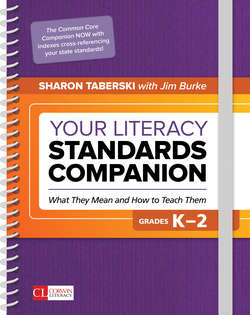Читать книгу Your Literacy Standards Companion, Grades K-2 - Jim Burke - Страница 27
Grades K–2 Common Core Reading Standard 1: Academic Vocabulary: Key Words and Phrases
ОглавлениеCite specific textual evidence: Readers need to reference the text to support their ideas, rather than simply stating opinions or referring to personal experiences; students should be able to reference illustrations or read words or sentences from the text that prove the points they are trying to make.
Conclusions drawn from the text: Readers take a group of details (different findings, series of events, related examples) and infer from them an insight or understanding about their meaning or importance within the passage or the text as a whole. These insights or conclusions are based on evidence found in the text.
Explicitly: This refers to anything that is clearly and directly stated in precise detail; it may suggest factual information or literal meaning, although this is not necessarily the case.
Informational texts: These include nonfiction texts written for a variety of purposes and audiences, such as expository texts, informational narratives (biography, history, journals and diaries, persuasive texts and essays). Informational texts include written arguments as well as visual images such as charts and diagrams.
Key details: These are parts of a text that support the main idea and enable the reader to draw conclusions/infer what the text or a portion of a text is about.
Literature: This refers to fiction, poetry, drama, and graphic stories as well as artworks by master painters or distinguished photographers.
Logical inferences (drawn from the text): To infer, readers add what they learned from the text to what they already know about the subject; however, for an inference to be “logical,” it must be based on evidence from the text.
Prompting and support: Here the teacher takes the lead role in helping students initiate a particular skill or strategy. She is likely to think aloud and model precisely what she wants students to be able to do on their own later, and to nurture their attempts.
Read closely (close reading): This refers to reading that emphasizes not only surface details but the deeper meaning and larger connections between words, sentences, and the full text; it also requires the reader to attend to the author’s craft, including organization, word choice, and style.
Text: In its broadest meaning, a text is whatever one is trying to read: a poem, essay, or article; in its more modern sense, a text can also be an image, an artwork, a speech, or a multimedia format such as a website or film.
Textual evidence: Not all evidence is created equal; students need to choose those pieces of evidence (illustrations, words, or sentences) that provide the best examples of what they are saying or the most compelling references to support their assertions.
